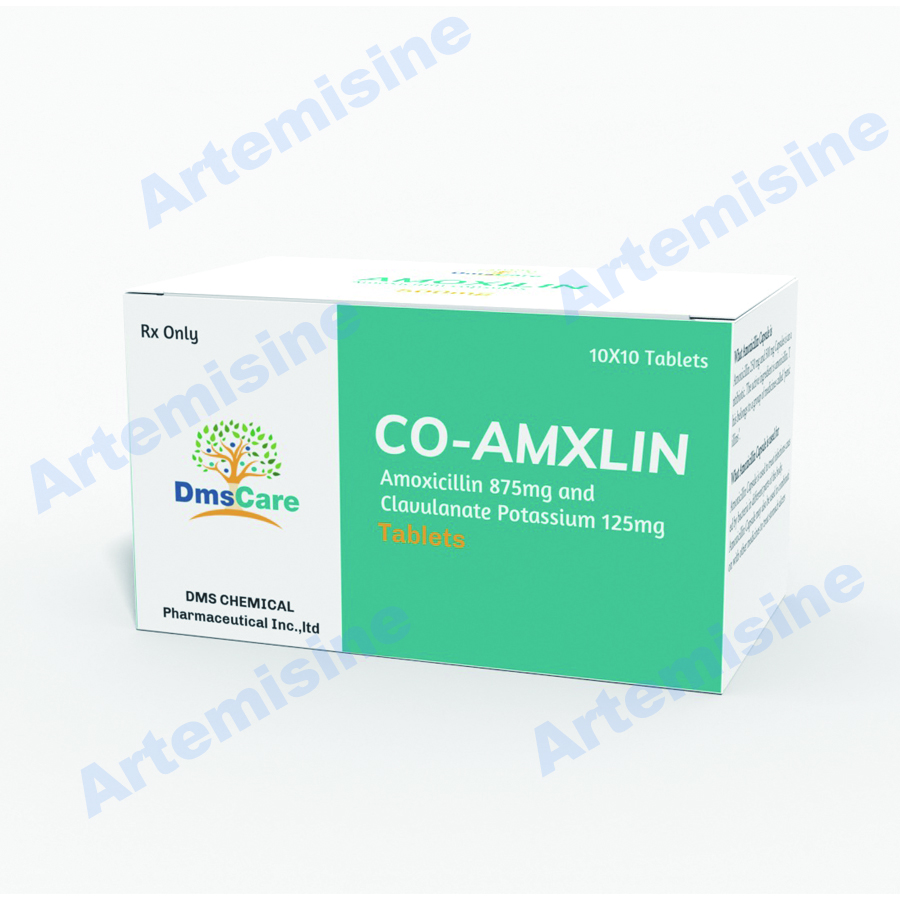Product Description
Products name: Co-Amxlin (Amoxicillin and Clavulanate) Tablets
Contains:
Amoxicillin/Clavulanate Potassium 875mg/125mg
Package:
10 tablets/ blister*10/ box;
Indications and Usage for Co-AmxlinTablets
C0-Amxlin tablet is a combination of amoxicillin, a penicillin-class antibacterial and clavulanate potassium, a beta-lactamase inhibitor indicated for treatment of the following infections in adults and pediatric patients:
- Lower respiratory tract infections
- Acute bacterial otitis media
- Sinusitis
- Skin and skin structure infections
- Urinary tract infections
Limitations of Use
When susceptibility test results show susceptibility to amoxicillin, indicating no beta-lactamase production, C0-Amxlin should not be used.
Usage
To reduce the development of drug-resistant bacteria and maintain the effectiveness of C0-Amxlin tablet and other antibacterial drugs, C0-Amxlin tablet should be used only to treat or prevent infections that are proven or strongly suspected to be caused by bacteria.
Co-Amxlin Tablets Dosage and Administration
- Adults and Pediatric Patients greater than 40 kg: 500 or 875 mg every 12 hours or 250 or 500 mg every 8 hours, based on amoxicillin component.
- Pediatric patients aged 12 weeks (3 months) and older: 25 to 45 mg/kg/day every 12 hours or 20 to 40 mg/kg/day every 8 hours, up to the adult dose.
- Neonates and infants less than 12 weeks of age: 30 mg/kg/day divided every 12 hours, based on the amoxicillin component. Use of the 125 mg/5 mL oral suspension is recommended.
Dosage Forms and Strengths
- Tablets: 875 mg/125 mg tablets are scored
Contraindications
- History of a serious hypersensitivity reaction (e.g., anaphylaxis or Stevens-Johnson syndrome) to amoxicillin and clavulanate potassium or to other beta-lactams (e.g., penicillins or cephalosporins).
- History of cholestatic jaundice/hepatic dysfunction associated with amoxicillin and clavulanate potassium.
Warnings and Precautions
- Serious (including fatal) hypersensitivity reactions: Discontinue amoxicillin and clavulanate potassium if a reaction occurs.
- Severe Cutaneous Adverse Reactions (SCAR): Monitor closely. Discontinue if rash progresses.
- Hepatic dysfunction and cholestatic jaundice: Discontinue if signs/symptoms of hepatitis occur. Monitor liver function tests in patients with hepatic impairment.
- Clostridioides difficile-associated diarrhea (CDAD): Evaluate patients if diarrhea occurs.
- Patients with mononucleosis who receive amoxicillin and clavulanate potassium develop skin rash. Avoid amoxicillin and clavulanate potassium use in these patients.
- Overgrowth: The possibility of superinfections with fungal or bacterial pathogens should be considered during therapy.
Adverse Reactions/Side Effects
The most frequently reported adverse reactions were diarrhea/loose stools (9%), nausea (3%), skin rashes and urticaria (3%), vomiting (1%) and vaginitis (1%).
Drug Interactions
- Co-administration with probenecid is not recommended.
- Concomitant use of amoxicillin and clavulanate potassium and oral anticoagulants may increase the prolongation of prothrombin time.
- Co-administration with allopurinol increases the risk of rash.
- Amoxicillin and clavulanate potassium may reduce efficacy of oral contraceptives.
Use In Specific Populations
- Pediatric Use: Modify dose in patients 12 weeks or younger.
- Renal Impairment: Dosage adjustment is recommended for severe renal impairment (GFR less than 30mL/min).
